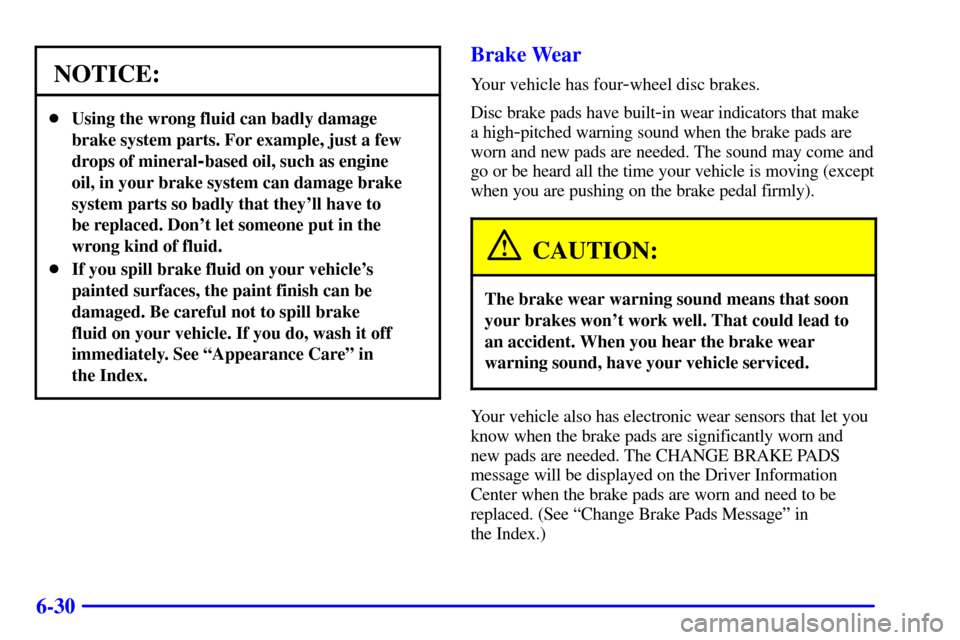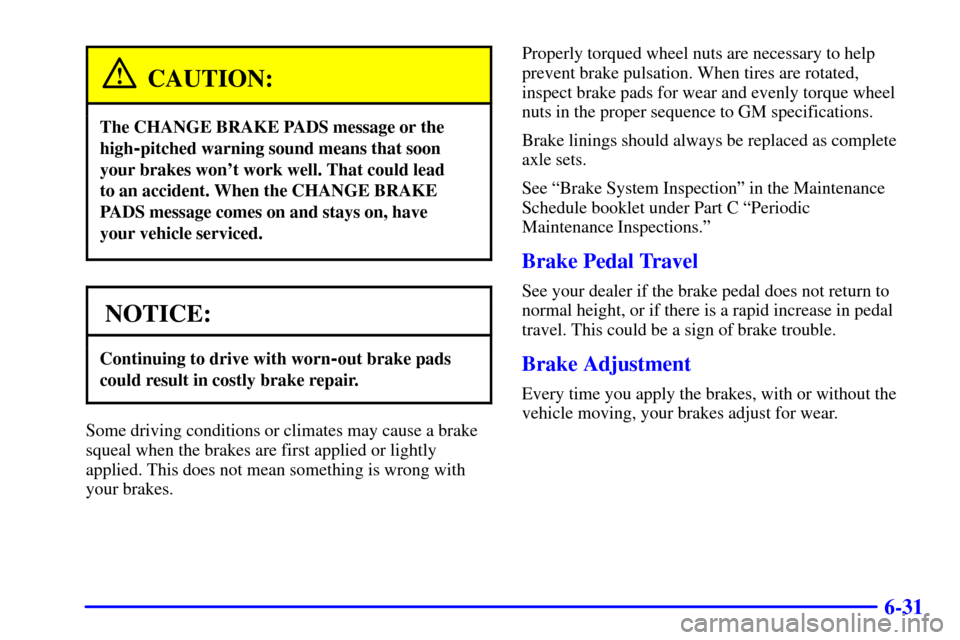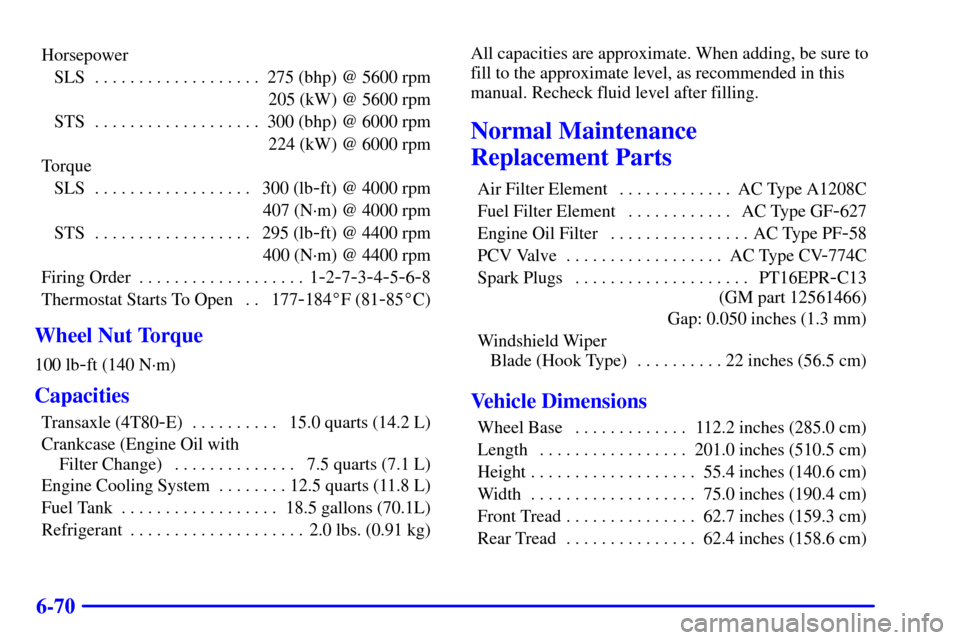Page 306 of 359

6-30
NOTICE:
�Using the wrong fluid can badly damage
brake system parts. For example, just a few
drops of mineral
-based oil, such as engine
oil, in your brake system can damage brake
system parts so badly that they'll have to
be replaced. Don't let someone put in the
wrong kind of fluid.
�If you spill brake fluid on your vehicle's
painted surfaces, the paint finish can be
damaged. Be careful not to spill brake
fluid on your vehicle. If you do, wash it off
immediately. See ªAppearance Careº in
the Index.
Brake Wear
Your vehicle has four-wheel disc brakes.
Disc brake pads have built
-in wear indicators that make
a high
-pitched warning sound when the brake pads are
worn and new pads are needed. The sound may come and
go or be heard all the time your vehicle is moving (except
when you are pushing on the brake pedal firmly).
CAUTION:
The brake wear warning sound means that soon
your brakes won't work well. That could lead to
an accident. When you hear the brake wear
warning sound, have your vehicle serviced.
Your vehicle also has electronic wear sensors that let you
know when the brake pads are significantly worn and
new pads are needed. The CHANGE BRAKE PADS
message will be displayed on the Driver Information
Center when the brake pads are worn and need to be
replaced. (See ªChange Brake Pads Messageº in
the Index.)
Page 307 of 359

6-31
CAUTION:
The CHANGE BRAKE PADS message or the
high
-pitched warning sound means that soon
your brakes won't work well. That could lead
to an accident. When the CHANGE BRAKE
PADS message comes on and stays on, have
your vehicle serviced.
NOTICE:
Continuing to drive with worn-out brake pads
could result in costly brake repair.
Some driving conditions or climates may cause a brake
squeal when the brakes are first applied or lightly
applied. This does not mean something is wrong with
your brakes.Properly torqued wheel nuts are necessary to help
prevent brake pulsation. When tires are rotated,
inspect brake pads for wear and evenly torque wheel
nuts in the proper sequence to GM specifications.
Brake linings should always be replaced as complete
axle sets.
See ªBrake System Inspectionº in the Maintenance
Schedule booklet under Part C ªPeriodic
Maintenance Inspections.º
Brake Pedal Travel
See your dealer if the brake pedal does not return to
normal height, or if there is a rapid increase in pedal
travel. This could be a sign of brake trouble.
Brake Adjustment
Every time you apply the brakes, with or without the
vehicle moving, your brakes adjust for wear.
Page 323 of 359

6-47
After the tires have been rotated, adjust the front and
rear inflation pressures as shown on the Tire
-Loading
Information label. Make certain that all wheel nuts
are properly tightened. See ªWheel Nut Torqueº in
the Index.
CAUTION:
Rust or dirt on a wheel, or on the parts to which
it is fastened, can make wheel nuts become loose
after a time. The wheel could come off and cause
an accident. When you change a wheel, remove
any rust or dirt from places where the wheel
attaches to the vehicle. In an emergency, you
can use a cloth or a paper towel to do this; but
be sure to use a scraper or wire brush later,
if you need to, to get all the rust or dirt off.
(See ªChanging a Flat Tireº in the Index.)
When It's Time for New Tires
One way to tell when it's
time for new tires is to
check the treadwear
indicators, which will
appear when your tires
have only 1/16 inch
(1.6 mm) or less of
tread remaining.
You need a new tire if any of the following statements
are true:
�You can see the indicators at three or more places
around the tire.
�You can see cord or fabric showing through the
tire's rubber.
�The tread or sidewall is cracked, cut or snagged deep
enough to show cord or fabric.
�The tire has a bump, bulge or split.
�The tire has a puncture, cut or other damage that
can't be repaired well because of the size or location
of the damage.
Page 346 of 359

6-70
Horsepower
SLS 275 (bhp) @ 5600 rpm. . . . . . . . . . . . . . . . . . .
205 (kW) @ 5600 rpm
STS 300 (bhp) @ 6000 rpm. . . . . . . . . . . . . . . . . . .
224 (kW) @ 6000 rpm
Torque
SLS 300 (lb
-ft) @ 4000 rpm . . . . . . . . . . . . . . . . . .
407 (N´m) @ 4000 rpm
STS 295 (lb
-ft) @ 4400 rpm . . . . . . . . . . . . . . . . . .
400 (N´m) @ 4400 rpm
Firing Order 1
-2-7-3-4-5-6-8 . . . . . . . . . . . . . . . . . . .
Thermostat Starts To Open 177
-184�F (81-85�C) . .
Wheel Nut Torque
100 lb-ft (140 N´m)
Capacities
Transaxle (4T80-E) 15.0 quarts (14.2 L). . . . . . . . . .
Crankcase (Engine Oil with
Filter Change) 7.5 quarts (7.1 L). . . . . . . . . . . . . .
Engine Cooling System 12.5 quarts (11.8 L). . . . . . . .
Fuel Tank 18.5 gallons (70.1L). . . . . . . . . . . . . . . . . .
Refrigerant 2.0 lbs. (0.91 kg). . . . . . . . . . . . . . . . . . . . All capacities are approximate. When adding, be sure to
fill to the approximate level, as recommended in this
manual. Recheck fluid level after filling.
Normal Maintenance
Replacement Parts
Air Filter Element AC Type A1208C. . . . . . . . . . . . .
Fuel Filter Element AC Type GF
-627 . . . . . . . . . . . .
Engine Oil Filter AC Type PF
-58 . . . . . . . . . . . . . . . .
PCV Valve AC Type CV
-774C . . . . . . . . . . . . . . . . . .
Spark Plugs PT16EPR
-C13 . . . . . . . . . . . . . . . . . . . .
(GM part 12561466)
Gap: 0.050 inches (1.3 mm)
Windshield Wiper
Blade (Hook Type) 22 inches (56.5 cm). . . . . . . . . .
Vehicle Dimensions
Wheel Base 112.2 inches (285.0 cm). . . . . . . . . . . . .
Length 201.0 inches (510.5 cm). . . . . . . . . . . . . . . . .
Height 55.4 inches (140.6 cm). . . . . . . . . . . . . . . . . . .
Width 75.0 inches (190.4 cm). . . . . . . . . . . . . . . . . . .
Front Tread 62.7 inches (159.3 cm). . . . . . . . . . . . . . .
Rear Tread 62.4 inches (158.6 cm). . . . . . . . . . . . . . .
Page:
< prev 1-8 9-16 17-24